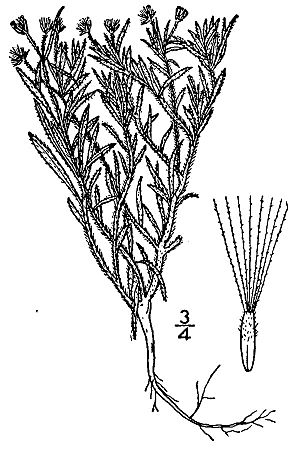Dwarf horseweed facts for kids
Quick facts for kids Dwarf horseweed |
|
|---|---|
 |
|
| Scientific classification | |
| Kingdom: | |
| (unranked): | |
| (unranked): | |
| (unranked): | |
| Order: | |
| Family: | |
| Tribe: |
Astereae
|
| Genus: |
Conyza
|
| Species: |
C. ramosissima
|
| Binomial name | |
| Conyza ramosissima Cronquist
|
|
| Synonyms | |
|
|
Conyza ramosissima (also known as dwarf horseweed) is a small plant found in North America. It belongs to the daisy family, which includes many common flowers like sunflowers and dandelions. This plant is very common across the central United States.
About Dwarf Horseweed
Dwarf horseweed is a type of plant that grows for only one year. It is known for having many branches. It can grow to be about 25 centimeters (10 inches) tall or even more.
What Does It Look Like?
The leaves of the dwarf horseweed are quite small. They are thin and look like threads. The plant has many tiny flower heads. Each flower head has small white or lavender ray florets. These are the petal-like parts on the outside. In the center, it has yellow disc florets. These are the tiny flowers that make up the center of the bloom.
Where Does It Grow?
This plant is found all over the central part of the United States. You can see it from New Mexico in the west to Alabama in the east. It also grows north into Pennsylvania, Ontario (Canada), and North Dakota. Dwarf horseweed often grows in places where the ground has been disturbed. This includes open fields and along roadsides.
How Did It Get Its Name?
The oldest name for this plant was Erigeron divaricatus. This name was given to it in 1803. Later, scientists decided to move the plant into a different group, called Conyza. There was already a plant from South America named Conyza divaricata. To avoid confusion, they gave our North American plant a new name: Conyza ramosissima. This is why it has two different scientific names.

